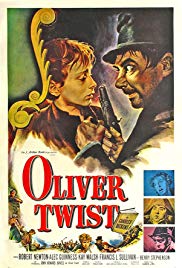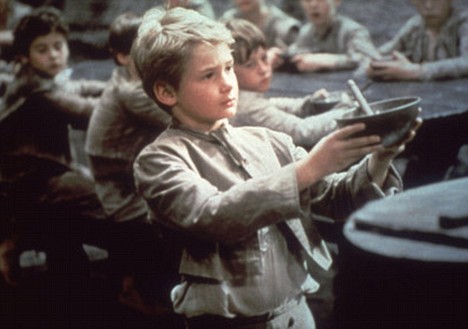OLIVER TWIST
SUBJECTS — Literature/England; World/England;
SOCIAL-EMOTIONAL LEARNING — Spousal Abuse; Crime;
MORAL-ETHICAL EMPHASIS — Caring.
AGE: 10+; No MPAA Rating;
Drama; 1948; 116 minutes; Color. Available from Amazon.com.
There is NO AI content on this website. All content on TeachWithMovies.org has been written by human beings.

SUBJECTS — Literature/England; World/England;
SOCIAL-EMOTIONAL LEARNING — Spousal Abuse; Crime;
MORAL-ETHICAL EMPHASIS — Caring.
AGE: 10+; No MPAA Rating;
Drama; 1948; 116 minutes; Color. Available from Amazon.com.
TWM offers the following worksheets to keep students’ minds on the movie and direct them to the lessons that can be learned from the film.
Film Study Worksheet for ELA Classes and
Worksheet for Cinematic and Theatrical Elements and Their Effects.
Teachers can modify the movie worksheets to fit the needs of each class. See also TWM’s Movies as Literature Homework Project.
This film recounts Charles Dickens’ classic tale of life among the poor and criminal elements in 19th century London.
Selected Awards:
None.
Featured Actors:
Robert Newton, John Howard Davies, Alec Guinness, Francis L. Sullivan, Anthony Newley, Kay Walsh, Diana Dors, Henry Stephenson.
Director:
David Lean.
“Oliver Twist” will introduce children to the 19th century London experienced by the poor. Nancy is beaten and then killed by her boyfriend when she tries to protect Oliver. This episode provides an opportunity to discuss spousal abuse.
MODERATE. Spousal abuse and the murder of a woman informant are shown. Alcohol use and abuse are shown.
Immediately after the movie, or at odd times over the next week (for example at the dinner table or in the car on the way to school) bring up some of the Discussion Questions, starting with the Quick Discussion Question. Don’t worry if you can only get through a few questions. Just taking the film seriously and discussing it is the key. Allow your child to watch the movie several times and continue to bring up discussion questions relating to the film.

Why did the children cling to Fagin? For a description of the oppressive system of treating the poor in England at the beginning of the 19th century, see Learning Guide to A Christmas Carol. The poor houses and orphanages were a part of that system. The children were required to work long hours and received precious little for it. The adult operators of these establishments often used them for their own profit. This was the life facing the Artful Dodger and the other children if they left Fagin.
Oliver Twist was Charles Dickens’ second novel and was originally published as a serial in a popular magazine from February 1837 to April 1839. The character of Oliver Twist the novel was the first child protagonist in an English novel. The book attempts a realistic portrayal of the sordid lives of criminals.
Dickens’ great novels always dealt with contemporary social evils and Oliver Twist is no exception. In the case of Oliver Twist the workhouse where poor children were sent to live, child labour, and the recruitment of children by criminals.
This story is about the criminal under class in London in the 19th century, the inadequate way in which Victorian society cared for the children of the poor, and the contest between good and evil. It challenges the Victorian idea that the environment in which a child is raised will have no influence on the adult that child becomes. Dickens challenges the belief that paupers are lazy and criminals are evil when they are born. Dickens contends that vice is caused by a corrupt environment while there are some, like Oliver, who are incorruptable.
Dickens considered charity in the Victorian England to be a failure. It was, like the work house in which Oliver lived, an opportunity for the rich and middle classes to live well at the expense of the poor. The Poor Law of 1834 permitted the indigent to receive government aid only if they lived in government workhouses. The workhouses were, in effect, slave labor camps. Children were required to work, families were almost always separated, and the food and clothing were meager. If the conditions at the poor houses were unpleasant, all the better. The poor would have more incentive to leave and get to work. However, workhouses did not typically provide any education or training to help the inmates better themselves and economic conditions (primarily dislocations from the industrial revolution) often made it difficult to find employment.
In the story crafted by Dickens, everyone eventually receives their just reward, except for Nancy, who is a classic victim of spousal abuse. Oliver is saved by the power of charity and love even though it is only a few of the many people that he meets who do not try to use him or seduce him into the criminal side of life. Fagin is hanged. The Artful Dodger is transported to Australia.
The charity and love exhibited by Oliver’s saviors is contrasted with the fake charity of Fagin who pretends to look out for Oliver and the other children who have fallen under his influence. In fact, he is using them as soldiers of his criminal enterprise.
1. Why did Bill Sykes beat Nancy?
2. Did the children have any choice other than to stay with Fagin and become pickpockets?
Discussion Questions Relating to Ethical Issues will facilitate the use of this film to teach ethical principles and critical viewing. Additional questions are set out below.
(Be kind; Be compassionate and show you care; Express gratitude; Forgive others; Help people in need)
1. Without caring people, what would have happened to Oliver Twist?
All books by Dickens are excellent reading for older children who are good readers. Remind them that the novel is much richer and has more detail than the movie. Other books recommended for middle school and junior high readers include Charles Dickens: The Man Who Had Great Expectations by Diane Stanley & Peter Vennema.
This Learning Guide was last updated on December 17, 2009.